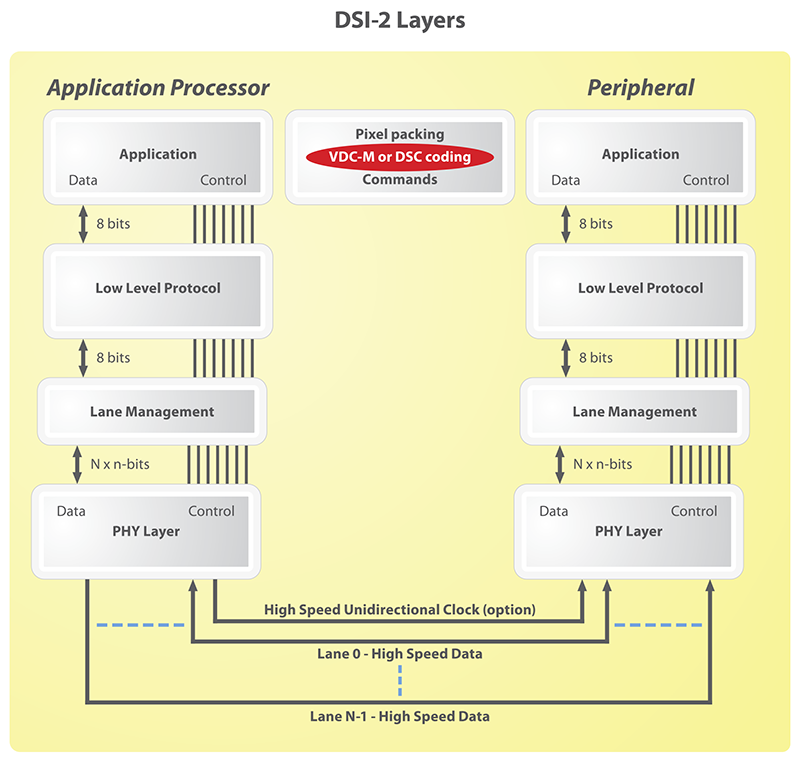MIPI DCS™
MIPI Display Command Set

Developed by: Display Working Group
Standardized command set for control of MIPI DSI-2 displays to reduce time to market and design cost for a broad range of displays
Quick Facts
-
Advantages
- Standardizes display control commands
- Reduces time to market and design cost
- Communicates any resolution to support a broad range of display types
-
Fundamental Features
- Used with MIPI Display Serial Interface 2 (DSI-2)
- Specifies a range of display control functions and defines method for supplying data to displays
- Supports Video Electronics Standards Association (VESA®) Display Stream Compression (DSC) and Display Compression-M (VDC-M)
- Supports MIPI DSE for automotive displays
-
Use Cases
- Mobile handsets
- Embedded displays
- Smart meters
- Video game devices
- Smartwatches
- Medical devices
- Wearables
- Virtual or augmented reality head-mounted devices
- Automotive displays
-
Physical Layer
C-PHY, D-PHY and A-PHY
Display Pixel Interface and Display Bus Interface
Get the Specification
-
Current Version
MIPI DCS℠ v2.1 (July 2024)
Member version
-
Related Specifications
-
Previous Versions
All DCS versions are available to MIPI members on the member website (Causeway).
Overview
General Info
-
Overview
MIPI Display Command Set (MIPI DCSSM) provides a standardized command set for control functions and supply of data to displays using MIPI Display Serial Interface 2 (DSI-2SM). It defines commands for all setup, control and test functions, including the control of settings such as resolution, width and brightness. DCS supports the Video Electronics Standards Association (VESA®) Display Stream Compression (DSC) and VESA Display Compression-M (VDC-M) standards. Optional features support MIPI Display Service Extensions (DSE) v1.0 for automotive functional safety and High-Bandwidth Digital Content Protection (HDCP).
MIPI DCS is developed by the MIPI Alliance Display Working Group.
Note: The specification is available only to MIPI Alliance members. For information about MIPI Alliance membership, visit Join MIPI.
-
Capabilities
Implementing the DCS specification reduces the time-to-market and design cost of mobile devices and other products by simplifying the interconnection of products from different manufacturers. It also simplifies the addition of new product features, such as larger or additional displays, due to the extensible nature of MIPI specifications.
-
Latest Release
MIPI DCS v2.1 includes new commands and data formats that supplement the new DSI-2 v2.2 specification for variable refresh rate, video hybrid mode, and 48-bit RGB and corresponding YCbCr sub-sampled command formats.
Version 2.0 of the DCS specification adds new commands for automotive applications: commands for passing the Frame Service Extension Data (FSED) structure used by the DSE (Display Service Extensions) v1.1, and commands for accessing the DSE and A-PHY register space.
Features added in MIPI DCS v1.5 include:- Support for optional adaptive refresh, allowing a peripheral to retain an image for an extended time, substantially reducing power consumption in a display panel
- Support for greater pixel depth and YCbCr 4:2:2 formats
- Additional commands for seamless, lossless transitions from video mode (active streaming) to command mode (static display), improving display efficiency, power consumption, reliability and user experience
- Optional features for automotive functional safety and HDCP through MIPI DSE v1.0
- Support for codec upgrades to the latest versions of VESA DSC and VDC‑M
-
Diagrams & Tables
Industries








